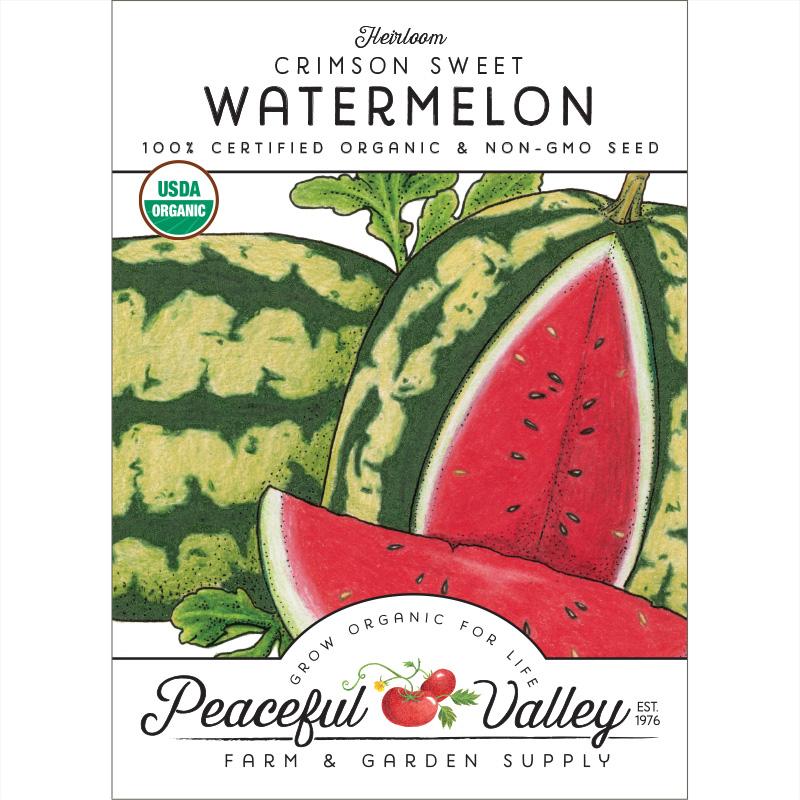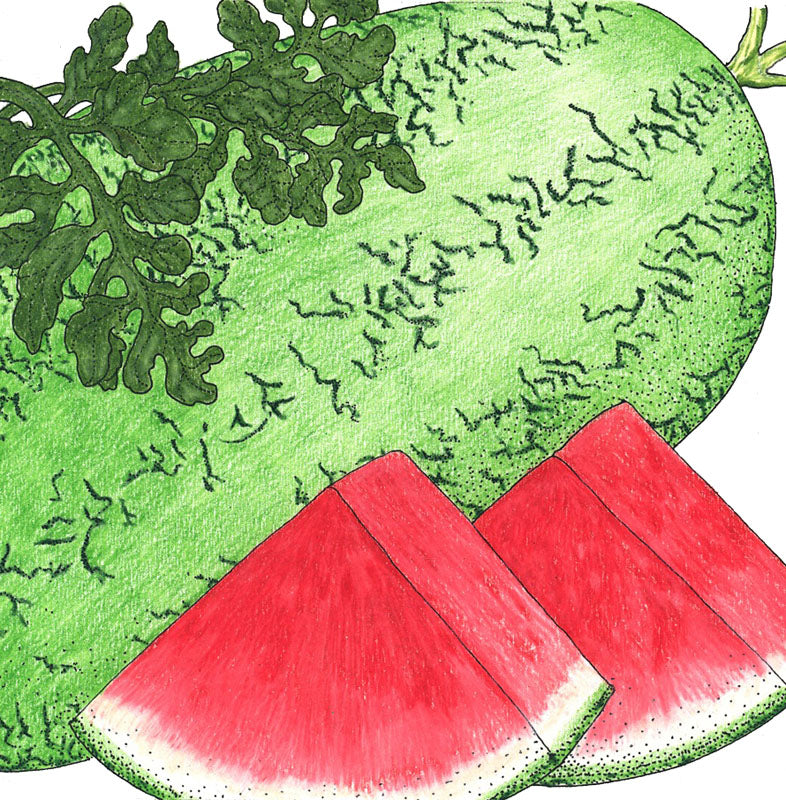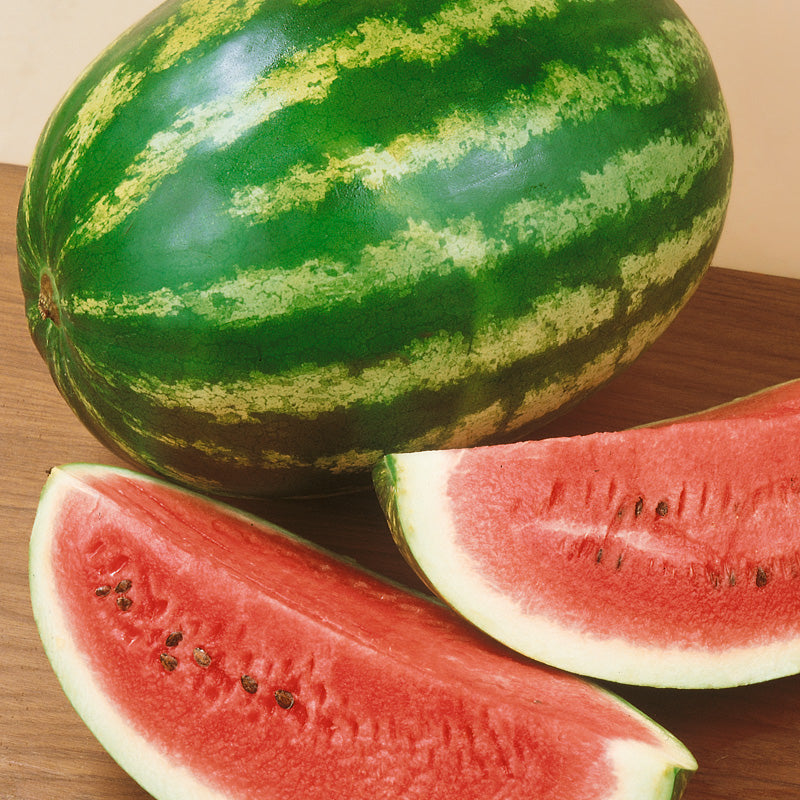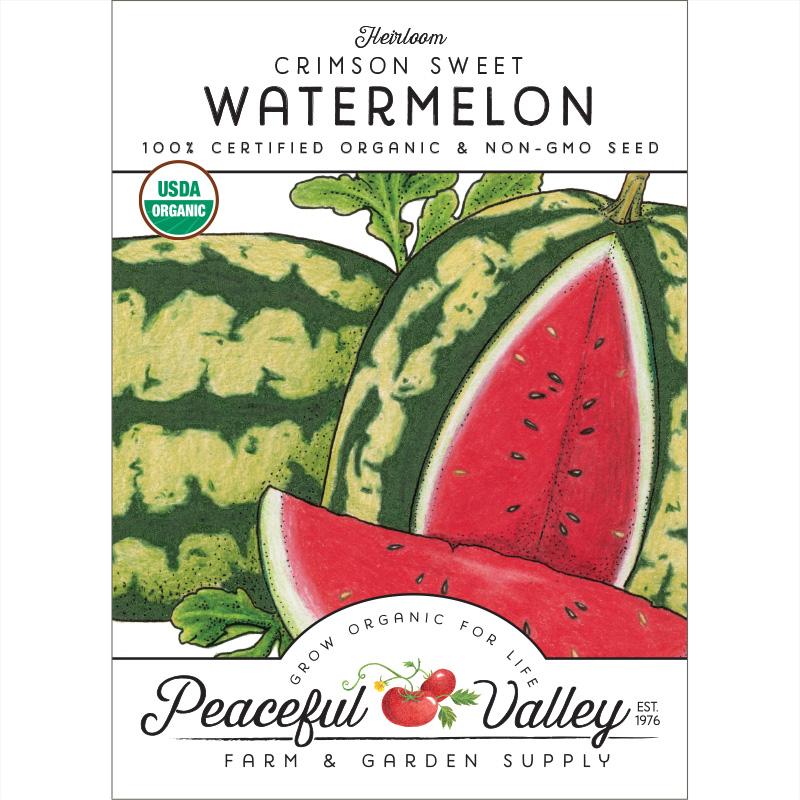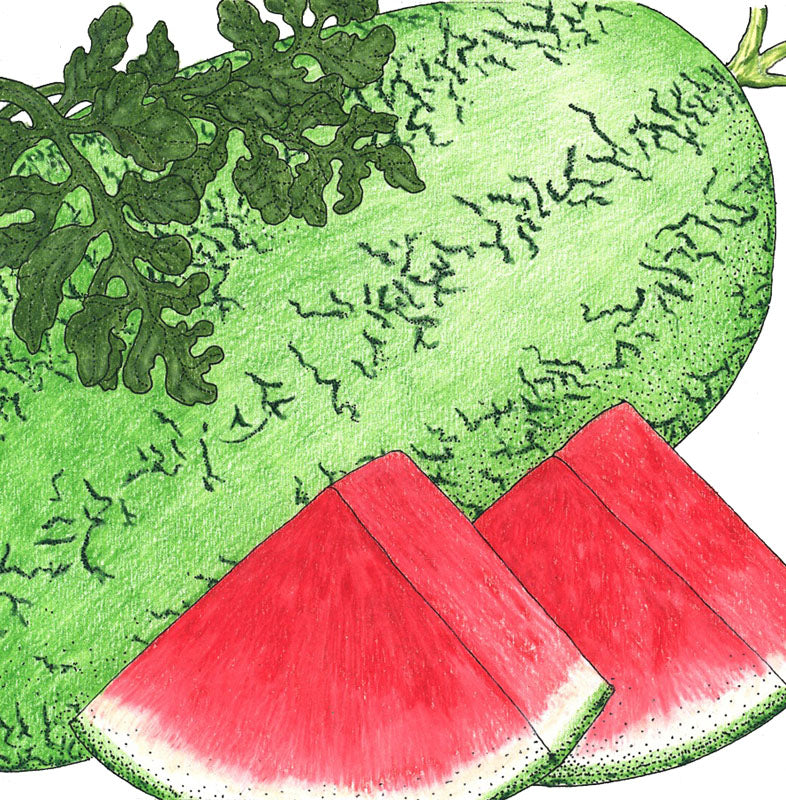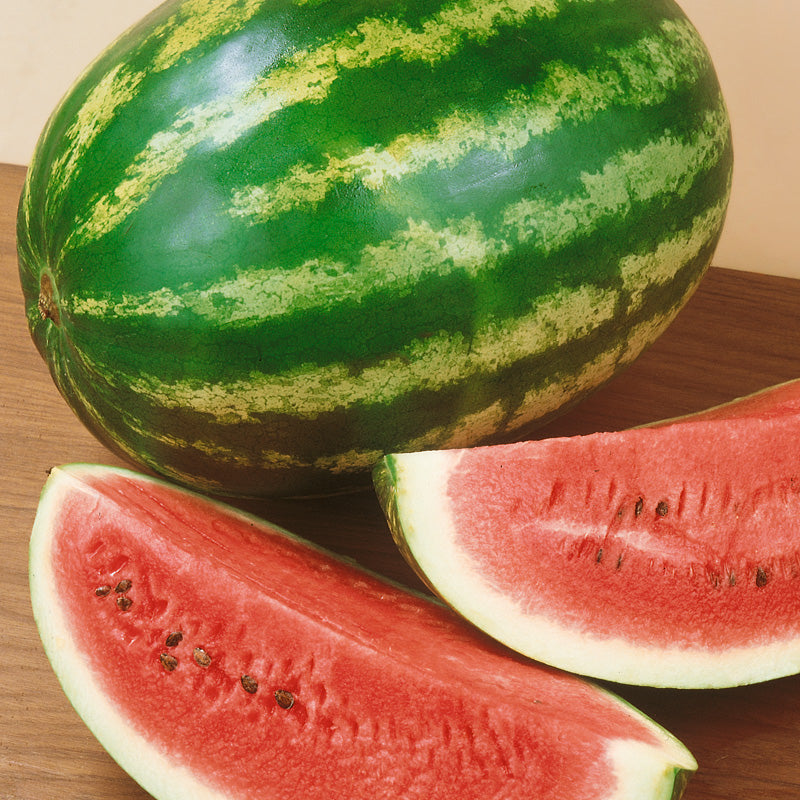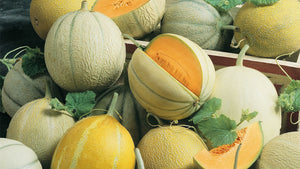Item Number: SNV8096
Crimson Sweet Watermelon Seeds (Organic)
Crimson Sweet Watermelon Seeds (Organic)
Crimson Sweet Watermelons - Flesh is Sweet with Few Small Seeds
Growing Zones: Suitable for USDA zones 6-9.
Chill Requirements: Typically, watermelons don't require specific chill hours for fruiting.
Bloom Time: Watermelon plants generally bloom in late spring to early summer.
Harvesting Dates: Crimson Sweet Watermelons are usually ready for harvest around mid-June to early July.
Looks: The Crimson Sweet Watermelon is characterized by its tough, medium-thick, light-green rind with small, dark-green stripes. It has bright, deep-red flesh.
Personality: Known for its high sugar content, this variety offers juicy, sweet-tart flesh with a delightful aroma.
Facts of Note: It's an All-American Selections winner, low in calories, high in lycopene, and suitable for various culinary uses.
Pollinator: Watermelons are generally self-pollinating.
Ideal Soil Temperatures: Watermelons prefer soil temperatures between 75°F to 95°F (24°C to 35°C) for optimal growth.
Planting Depths: Sow seeds about 1/2 inch deep in well-draining soil.
Germination Periods: Watermelon seeds typically germinate within 3-9 days.
Height at Maturity: Vines can grow up to 18-24 inches in height.
Days to Maturity: Crimson Sweet Watermelons usually mature in around 88 days.
Sun/ Shade: Requires full sun for optimal growth and fruit production.
Spacing After Thinning: Proper spacing is crucial for healthy growth; plant watermelon seeds or seedlings about 4-6 feet apart.
Approx Seeds per Pack: 25 Seeds
Growing nectarine trees
To foster optimal growth and abundant harvests, understanding the nuances of cultivating these fruit-bearing trees is essential.
Choosing Suitable Varieties:
Nectarine trees come in various cultivars, each with distinct traits. Selecting an appropriate variety depends on factors like local climate, available space, and personal preferences. Varieties like 'Independence,' 'Fantasia,' or 'Sun Blaze' offer different flavors, chilling hour requirements, and disease resistance levels.
Climate and Soil Conditions:
Nectarine trees thrive in moderate climates with well-draining soil. They demand ample sunlight exposure, ideally six hours per day, for quality fruit production. While adaptable to various soil types, a pH range of 6.0 to 7.0 is optimal. Ensuring proper drainage mitigates the risk of root rot.
Planting and Spacing:
When planting nectarine trees, choose a location with good airflow to prevent fungal diseases. Dig a hole slightly larger than the root system and place the tree, ensuring the graft union sits above the soil line. Adequate spacing, usually between 12 to 20 feet between trees, allows for growth and airflow.
Watering and Fertilization:
Young nectarine trees necessitate regular watering, especially during dry periods. Once established, they still require consistent moisture but can withstand short drought periods. Applying organic mulch around the base aids in retaining soil moisture and regulating temperature. Annual fertilization with a balanced fertilizer in early spring supports growth and fruit development.
Pruning and Maintenance:
Pruning plays a pivotal role in shaping the tree, removing dead or diseased branches, and encouraging fruit production. Conduct major pruning during the dormant season to stimulate new growth. Regular inspection for pests and diseases is crucial, addressing any issues promptly to maintain tree health.
Pollination:
Most nectarine varieties are self-pollinating, yet having multiple trees nearby can enhance yields. Bees play a vital role in pollination, so cultivating pollinator-friendly plants nearby can bolster fruit set.
Harvesting and Storage:
Nectarines typically ripen in mid to late summer, varying by variety and local climate. Harvest fruit when it reaches full color, slightly softens, and easily detaches from the tree. Ripe nectarines can be stored in the refrigerator for a few days or frozen for prolonged preservation.
Nectarine trees offer a delectable addition to any orchard or garden, providing juicy, flavorful fruit when given proper care and attention. Their versatility and taste make them a prized addition, yielding rewarding harvests for years to come.
Nectarine trees offer a rewarding experience, producing succulent, bright red fruit perfect for home orchards. By understanding their needs in terms of soil, climate, and care, growers can foster these trees to yield abundant and delicious harvests season after season.

Check Your Zone Compatibility:
Compatible with your zone.
Growing Zone for
,

Our Guarantee To You
Since 1976, we've served our customers at every stage of growing. Please contact us at any time. We are happy to support and assist you.
Description
Description
Growing Zones: Suitable for USDA zones 6-9.
Chill Requirements: Typically, watermelons don't require specific chill hours for fruiting.
Bloom Time: Watermelon plants generally bloom in late spring to early summer.
Harvesting Dates: Crimson Sweet Watermelons are usually ready for harvest around mid-June to early July.
Looks: The Crimson Sweet Watermelon is characterized by its tough, medium-thick, light-green rind with small, dark-green stripes. It has bright, deep-red flesh.
Personality: Known for its high sugar content, this variety offers juicy, sweet-tart flesh with a delightful aroma.
Facts of Note: It's an All-American Selections winner, low in calories, high in lycopene, and suitable for various culinary uses.
Pollinator: Watermelons are generally self-pollinating.
Ideal Soil Temperatures: Watermelons prefer soil temperatures between 75°F to 95°F (24°C to 35°C) for optimal growth.
Planting Depths: Sow seeds about 1/2 inch deep in well-draining soil.
Germination Periods: Watermelon seeds typically germinate within 3-9 days.
Height at Maturity: Vines can grow up to 18-24 inches in height.
Days to Maturity: Crimson Sweet Watermelons usually mature in around 88 days.
Sun/ Shade: Requires full sun for optimal growth and fruit production.
Spacing After Thinning: Proper spacing is crucial for healthy growth; plant watermelon seeds or seedlings about 4-6 feet apart.
Approx Seeds per Pack: 25 Seeds
Growing nectarine trees
To foster optimal growth and abundant harvests, understanding the nuances of cultivating these fruit-bearing trees is essential.
Choosing Suitable Varieties:
Nectarine trees come in various cultivars, each with distinct traits. Selecting an appropriate variety depends on factors like local climate, available space, and personal preferences. Varieties like 'Independence,' 'Fantasia,' or 'Sun Blaze' offer different flavors, chilling hour requirements, and disease resistance levels.
Climate and Soil Conditions:
Nectarine trees thrive in moderate climates with well-draining soil. They demand ample sunlight exposure, ideally six hours per day, for quality fruit production. While adaptable to various soil types, a pH range of 6.0 to 7.0 is optimal. Ensuring proper drainage mitigates the risk of root rot.
Planting and Spacing:
When planting nectarine trees, choose a location with good airflow to prevent fungal diseases. Dig a hole slightly larger than the root system and place the tree, ensuring the graft union sits above the soil line. Adequate spacing, usually between 12 to 20 feet between trees, allows for growth and airflow.
Watering and Fertilization:
Young nectarine trees necessitate regular watering, especially during dry periods. Once established, they still require consistent moisture but can withstand short drought periods. Applying organic mulch around the base aids in retaining soil moisture and regulating temperature. Annual fertilization with a balanced fertilizer in early spring supports growth and fruit development.
Pruning and Maintenance:
Pruning plays a pivotal role in shaping the tree, removing dead or diseased branches, and encouraging fruit production. Conduct major pruning during the dormant season to stimulate new growth. Regular inspection for pests and diseases is crucial, addressing any issues promptly to maintain tree health.
Pollination:
Most nectarine varieties are self-pollinating, yet having multiple trees nearby can enhance yields. Bees play a vital role in pollination, so cultivating pollinator-friendly plants nearby can bolster fruit set.
Harvesting and Storage:
Nectarines typically ripen in mid to late summer, varying by variety and local climate. Harvest fruit when it reaches full color, slightly softens, and easily detaches from the tree. Ripe nectarines can be stored in the refrigerator for a few days or frozen for prolonged preservation.
Nectarine trees offer a delectable addition to any orchard or garden, providing juicy, flavorful fruit when given proper care and attention. Their versatility and taste make them a prized addition, yielding rewarding harvests for years to come.
Nectarine trees offer a rewarding experience, producing succulent, bright red fruit perfect for home orchards. By understanding their needs in terms of soil, climate, and care, growers can foster these trees to yield abundant and delicious harvests season after season.
Peaceful Valley Farm & Garden Supply brand seeds  are guaranteed to germinate. Once the seeds have sprouted, please understand that Peaceful Valley cannot be held responsible for the many uncontrollable growing and climatic conditions that must be met to ensure the success of your crop(s). Peaceful Valley brand vegetable seeds are all non-GMO and Certified Organic.
are guaranteed to germinate. Once the seeds have sprouted, please understand that Peaceful Valley cannot be held responsible for the many uncontrollable growing and climatic conditions that must be met to ensure the success of your crop(s). Peaceful Valley brand vegetable seeds are all non-GMO and Certified Organic.
Buy with confidence and plant the best!
Shipping Information
Shipping Information
Shipping Weight: 0.01 lb
Dimensions: 4.5"L x 3.25"W x 0.1"H
Features
Features
- Heirloom
- Open-Pollinated
Characteristics
Characteristics
Planting & Care
Planting & Care
Soil & Water: Watermelon prefers light, loamy, fertile, deep, well-draining soil with a pH of 5.5-6.5. Add plenty of organic matter. Water plants amply until setting out, then water more sparingly. Mulch to prevent weed competition.
Planting & Growing: Start seeds indoors 2-3 weeks before the last frost or sow seeds directly after frost. Set out 3-4 transplants per hill, selecting the strongest two when vines are 1'-2' long. Watermelons are large vining plants that can take over an extensive garden space. They can be trellised, but use slings to support the developing fruit.
Harvesting & Storage: Harvest melons when the tendril closest to the stem turns dry and brown and the stem becomes brittle. Eat fresh, freeze flesh in a honey-based syrup, or pickle the rind.
Useful Information
Useful Information
Guarantee
Guarantee

Peaceful Valley Farm & Garden Supply brand vegetable seeds are guaranteed to germinate. Once the seeds have sprouted, please understand that Peaceful Valley cannot be held responsible for the many uncontrollable growing and climatic conditions that must be met to ensure the success of your crop(s).
Share
